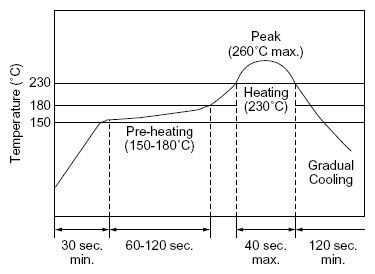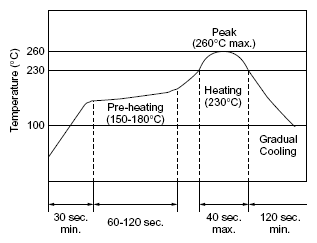
Reflow
One heat stress, shown in the profile at right, is applied to resonator, then after being placed in natural conditions for 1 hour, the resonator is measured.
Soldering Iron
Soldering iron of +300±5°C should be placed 0.5mm above electrode of resonator. Melting solder through soldering iron should be applied to electrode for 3±1 seconds; then, after being placed in natural conditions for 24 hour, the resonator should be measured.
Please contact us in case you need washable component.
The component cannot withstand washing. Please do not apply excessive mechanical stress to the component and lead terminals during soldering.
Product Storage Condition
Please store the products in room where the temperature/humidity is stable.
And avoid such places where there are large temperature changes.
Please store the products under the following conditions:
Notice on Product Storage
Expire Date on Storage
Expire date (Shelf life) of the products is 3 months after delivery under the conditions of a sealed and an unopened package.
Please use the products within 3 months after delivery.
If you store the products for a long time (more than 3 months), use carefully because the products may be degraded in the solderability and/or rusty.
Please confirm solderability and characteristics for the products regularly.
Others
Conformal coating or washing of the component is not acceptable because it is not hermetically sealed. Please be sure to consult with our sales representative or engineer whenever and prior to using the products.
The component may be damaged if excess mechanical stress is applied.
Piezo ceramic may stop oscillating or oscillate irregularly under improper circuit conditions.

Reflow
Filter is soldered twice within the following temperature conditions.
Soldering Iron
Filter is soldered at +350±5°C for 3.0±0.5 seconds. The soldering iron should not touch the filter while soldering.
The component cannot withstand washing.
Download Precautions of Ceramic Filters & Resonators in PDF file.